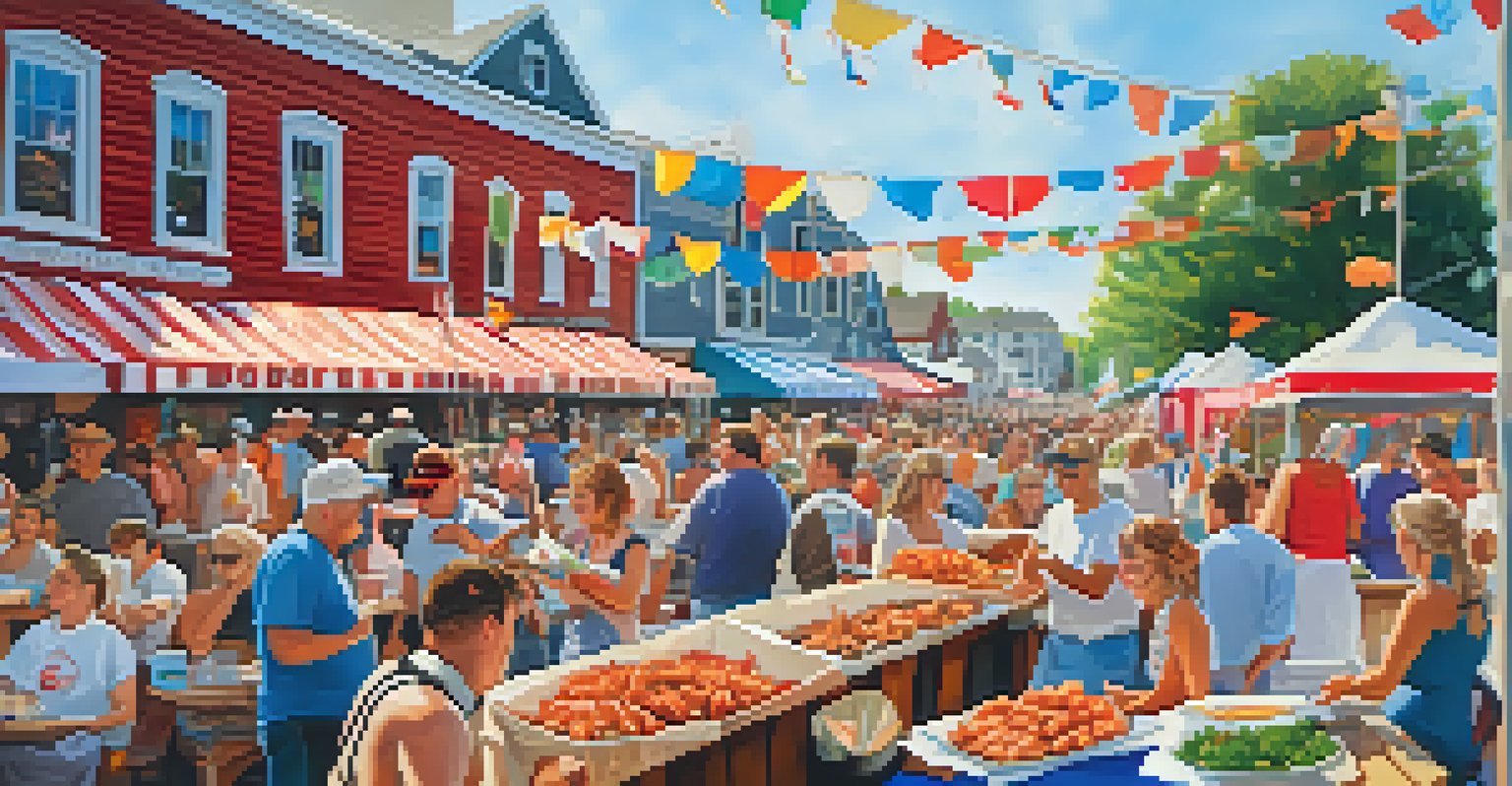New England’s Seafood Traditions: A Culinary Adventure

The Rich History of New England's Seafood Cuisine
New England's seafood traditions are steeped in history, dating back to the early Indigenous peoples who relied on the bountiful waters for sustenance. Over the centuries, European settlers arrived and brought their culinary practices, melding them with local ingredients. This fusion laid the groundwork for a unique seafood culture that thrives today, celebrating the region's maritime heritage.
The sea, once it casts its spell, holds one in its net of wonder forever.
From the bustling fishing ports to the quaint coastal towns, seafood has shaped the identity of New England. Lobsters, clams, and scallops are not just ingredients; they represent a way of life for many communities. The region's deep connection to the ocean fosters a passion for sustainable fishing practices, ensuring that these traditions can be passed down through generations.
As you stroll along the picturesque coastline, it's hard to miss the influence of seafood on local festivals, markets, and restaurants. Events celebrating the harvest of the sea, like clam bakes and lobster fests, draw both locals and tourists alike, showcasing the importance of seafood in New England's culinary landscape.
Iconic Dishes: A Taste of the Coast
When you think of New England seafood, certain iconic dishes come to mind. Clam chowder, for instance, is a creamy, comforting soup that has become synonymous with the region. Often served in a bread bowl, this dish reflects the hearty nature of New England cuisine, perfect for warming up after a day by the sea.

Another quintessential dish is the lobster roll, a simple yet decadent treat that highlights the freshness of the lobster meat. Typically served in a toasted bun with a light dressing, this sandwich is a must-try for anyone visiting the area. Each bite is a reminder of the ocean's bounty and the craftsmanship of local chefs who prepare it with care.
New England's Seafood Heritage
The region's seafood traditions blend Indigenous practices with European influences, creating a unique culinary culture.
Don't forget about fried clams, which are often regarded as a staple of New England summer fare. These crispy delights, typically served with a side of tartar sauce, evoke nostalgic memories of beach days and family gatherings. Together, these dishes paint a delicious portrait of the region's culinary offerings.
The Influence of Local Ingredients
In New England, the freshest seafood comes from local waters, making regional ingredients crucial to its culinary traditions. Fishermen work tirelessly to provide an array of options, from haddock to oysters, ensuring that each meal reflects the sea's seasonal bounty. This commitment to local sourcing is what keeps the cuisine vibrant and connected to the land.
Eating good food is a form of self-respect.
Farmers markets and seafood shacks dot the landscape, offering a direct line to the freshest catches. Here, you can find everything from wild-caught fish to artisanal shellfish, each contributing to the rich tapestry of New England's cuisine. The emphasis on local ingredients not only supports the economy but also enhances the flavors of traditional dishes.
As chefs embrace these local ingredients, they create innovative dishes that honor the region's seafood heritage. This blend of tradition and creativity allows for a dynamic culinary scene where classic recipes are reimagined, showcasing the best of what New England has to offer.
Sustainable Fishing Practices in New England
Sustainability is at the heart of New England's seafood traditions, as communities recognize the importance of preserving their marine resources. Overfishing and climate change pose significant threats, prompting a shift toward more responsible fishing practices. Local fishermen and organizations are working together to implement measures that ensure a healthy ocean for future generations.
One popular initiative is the use of catch shares, which allocate a percentage of the total allowable catch to individual fishermen. This system encourages responsible harvesting and helps maintain fish populations. By prioritizing sustainability, New England is setting a precedent for other regions to follow, showcasing how culinary traditions can coexist with environmental stewardship.
Sustainability in Seafood Practices
Local communities prioritize sustainable fishing methods to protect marine resources and ensure the future of seafood traditions.
Many restaurants and seafood markets proudly display their commitment to sustainability, often sourcing from local, certified fisheries. Diners are increasingly seeking out these options, eager to support practices that protect the ocean while enjoying fresh, delicious seafood. This growing awareness reflects a broader trend toward conscious eating that resonates with both locals and visitors.
Seafood Festivals: Celebrating Culinary Heritage
Seafood festivals are a vibrant celebration of New England's rich culinary heritage, drawing crowds from far and wide. These events often feature cooking demonstrations, tastings, and local vendors showcasing their finest seafood offerings. Attendees can indulge in everything from clam chowder to lobster rolls while soaking in the lively atmosphere of music and community.
One of the most famous festivals is the Maine Lobster Festival, held annually in Rockland. This week-long event celebrates the region's most beloved crustacean with activities like the lobster crate race and a sea goddess coronation. It's not just about the food; it's about honoring the hard work of fishermen and the traditions that have shaped the local culture.
Festivals like these foster a sense of community, connecting people with the stories behind their food. As locals and tourists gather to enjoy seafood together, they partake in a shared experience that emphasizes the importance of cultural heritage, sustainability, and the joy of good food.
Exploring Seafood Markets: A Treasure Trove of Flavors
A visit to New England wouldn't be complete without exploring its bustling seafood markets. These vibrant hubs are where the freshest catches of the day are brought in and sold directly to consumers. Walking through these markets, you can see a dazzling array of fish, shellfish, and other ocean delights, often accompanied by the friendly banter of local fishermen and vendors.
At these markets, you can engage with knowledgeable sellers who are passionate about their trade. They can share stories about where the seafood came from, how it was caught, and even offer cooking tips to help you prepare the perfect meal at home. This connection to the source deepens your appreciation for the food you eat and the traditions surrounding it.
Celebrating Seafood Festivals
Seafood festivals in New England highlight local cuisine and foster community connections through food and cultural heritage.
Many markets also host cooking classes and tastings, allowing visitors to gain hands-on experience with the region's seafood. These interactive experiences not only educate but also foster a deeper understanding of the flavors and techniques that define New England's culinary scene.
The Future of New England's Seafood Traditions
As we look ahead, the future of New England's seafood traditions is bright, yet it comes with challenges. Climate change, overfishing, and shifting consumer preferences will continue to shape the way seafood is caught, prepared, and enjoyed. However, the commitment to sustainability and local sourcing provides a solid foundation for the resilience of these traditions.
Innovative chefs and local organizations are at the forefront of this evolution, experimenting with new recipes and techniques while honoring the past. They are finding ways to adapt traditional dishes to reflect the changing landscape, ensuring that the rich flavors of New England seafood remain relevant and exciting.

Ultimately, the future lies in the balance between tradition and innovation, community and sustainability. By embracing both the heritage and the evolving nature of seafood cuisine, New England can continue to be a beacon of culinary excellence for generations to come.